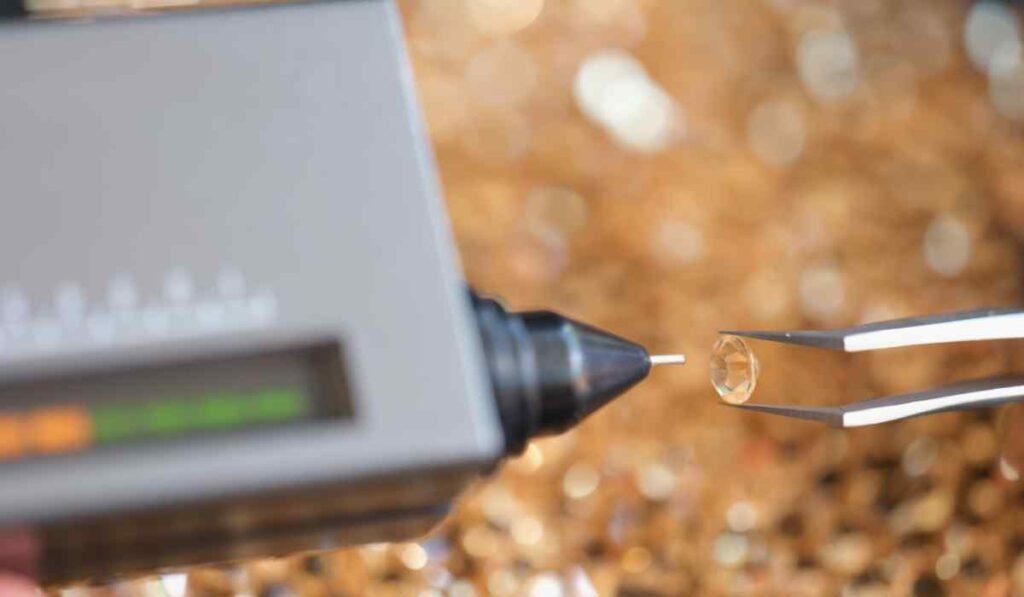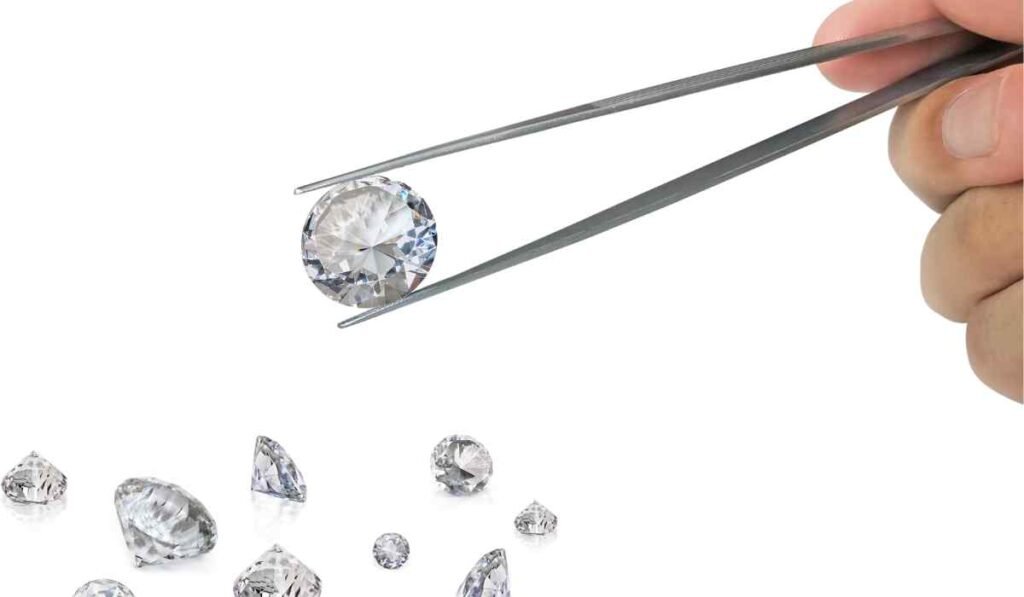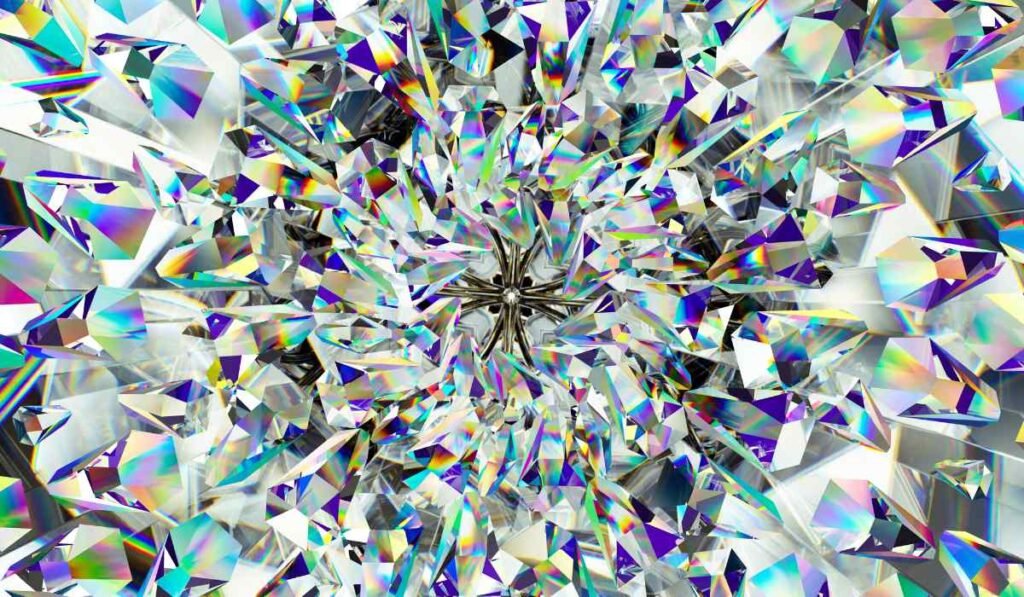Understanding the authenticity of a diamond is crucial, especially when making a significant purchase. Whether you’re a seasoned gem enthusiast or a curious buyer, the quest to decipher the authenticity of a diamond is crucial.
In this guide, we’ll delve into the characteristics of real diamonds and provide both DIY and professional methods to help you differentiate between genuine and fake stones.
Let’s first know what the real definition of a real diamond is.
Table of Contents
ToggleWhat is a diamond?
A diamond is a precious gemstone formed deep within the Earth’s mantle under intense pressure and heat. Composed of carbon atoms arranged in a crystal lattice structure, diamonds are renowned for their exceptional hardness, making them the hardest natural substance. Their brilliance and sparkle result from the way they refract light.

Characteristics of Real Diamonds:
Hardness:
Real diamonds are one of the hardest substances on Earth. Test your diamond’s hardness by attempting to scratch it with another surface. Genuine diamonds will not scratch easily.
Brilliance:
Authentic diamonds exhibit exceptional brilliance and sparkle. Place the diamond under bright light and observe the reflections; genuine diamonds will distinctively disperse light.
Refraction:
Diamonds have a high refractive index. Hold the diamond over a printed text; real diamonds will refract light in a way that makes the text almost invisible.
Understanding the Basics: The 4 Cs of Diamonds
Before embarking on the journey to unveil a diamond’s authenticity, it’s imperative to grasp the fundamentals. The 4 Cs—Cut, Color, Clarity, and Carat—serve as the cornerstone of diamond evaluation. A real diamond boasts a meticulous balance of these characteristics, contributing to its unparalleled allure.
1. Cracking the Cut: The Symphony of Reflection
The cut of a diamond is akin to a symphony, orchestrating the reflection of light in a mesmerizing dance. Genuine diamonds exhibit precision in their cut, allowing light to refract brilliantly. Look for terms like “Excellent” or “Ideal” in the cut grade when evaluating a diamond’s authenticity.
2. Color Clues: The Spectrum of Purity
Diamonds come in an array of colors, but true diamonds possess a crystalline purity that sets them apart. Authentic diamonds are graded on a color scale, with D being completely colorless. Aim for diamonds in the D to F range for the purest hues.
3. Clear as Day: Deciphering Clarity
The clarity of a diamond reveals its inner world of imperfections or lack thereof. Genuine diamonds have minimal flaws, known as inclusions, visible under magnification. Opt for diamonds with a clarity grade of VS1 (Very Slightly Included) or higher for utmost clarity.
4. Carat Weight: Weighing the Brilliance
Carat weight, often misconstrued as size, is a crucial factor in diamond evaluation. While size matters, it’s the balance of all the 4 Cs that defines a real diamond’s brilliance. Ensure the carat weight aligns harmoniously with cut, color, and clarity for an authentic gem.
12 Diamond Test Methods

1. The Breath Test
Ever wondered if your breath can reveal the truth about your diamond? Blow gently on the surface of the stone; a real diamond disperses heat instantaneously, while fake ones may retain the heat longer.
2. Sparkling Reflections
Have you observed the sparkle closely? Authentic diamonds showcase a mesmerizing play of light, often described as the “fire” of the diamond. Fakes lack this brilliance, offering a dull appearance.
3. The Foggy Mirror Trick
Is your diamond playing hide and seek with fog? Breathe on the diamond; real diamonds clear up swiftly due to their efficient heat conductivity. Fake ones might take longer to reveal their clarity.
4. Weighty Matters
Is your diamond pulling its weight? Real diamonds are dense, and their weight can be a clue to authenticity. Use a carat scale to compare against the expected weight of a genuine diamond.
5. Magnify, Magnify, Magnify
Zoom into the details! Authentic diamonds often contain tiny imperfections called inclusions. Under a jeweler’s loupe, these inclusions can be spotted, verifying the diamond’s real nature.
6. The Scratch Test
Can your diamond withstand the test of toughness? While we don’t recommend this at home, professionals use a scratch test on certain materials. Authentic diamonds are extremely hard and resist scratches.
7. Thermal Conductivity
Real or fake? Check the temperature! Diamonds disperse heat quickly. Conduct a simple touch test by placing the stone against your cheek – a real diamond feels cool due to its efficient thermal conductivity.
8. The UV Light Test
Shine a light on the truth! Under ultraviolet light, some diamonds emit a bluish fluorescence. While not foolproof, this can be a hint towards authenticity.

9. Professional Appraisal
When in doubt, trust the experts! Seek professional appraisers who use specialized tools to examine diamonds. Their trained eyes can discern the subtle differences between real and fake.
10. The Price Tag Reality
Does the deal seem too good to be true? Authentic diamonds come with a certain price tag. Unrealistically low prices may signal a counterfeit. Research and compare prices to ensure you’re getting what you pay for.
11. The Setting Check
Inspect the setting! Authentic diamonds are often set in high-quality materials like platinum or gold. A poorly crafted setting may indicate a fake.
12. Certification Credentials
Seek the paperwork! Genuine diamonds come with certificates from recognized gemological laboratories. Insist on certification to validate the authenticity of your precious stone.
Here are some of the commonly asked questions:
how to tell if a diamond is real with a flashlight
To check if a diamond is real with a flashlight, observe its sparkle. Real diamonds show strong brilliance with sharp, distinct flashes of light. Fake diamonds may display a rainbow-like sparkle or less defined reflections. For certainty, professional gemological testing is recommended.
How can you test if a diamond is real at home?
To test if a diamond is real at home, use a magnifying glass to inspect for imperfections and check for sharp reflections of light. Real diamonds typically have tiny flaws and exhibit strong brilliance. However, for accurate results, professional gemological testing is advisable.

How do you tell if a ring is real or fake?
Examine its markings for authenticity, such as hallmarks indicating metal quality. Genuine gemstones like diamonds should display brilliance, while synthetic materials may lack natural diamond sparkle. Professional appraisal and testing provide the most reliable confirmation.
How can you tell a diamond from a cubic zirconia?
Consider factors like brilliance and hardness. Diamonds have exceptional sparkle and are the hardest natural substance, while cubic zirconia may display more colorful flashes and is less durable. Professional gemological testing ensures accurate identification.
How can you tell if a diamond is real through a loop?
look for tiny imperfections or “inclusions” and examine the edges of facets. Genuine diamonds often have unique, natural flaws, while fake ones may lack these intricate details. For certainty, professional gemological testing is recommended.
Conclusion
Finding a real diamond involves a careful examination of its cut, color, clarity, and carat weight. Employing advanced techniques like the Fog Test and understanding the characteristics of impostors ensures a foolproof assessment.
Remember, with DIY and professional tests, you can confidently ensure the authenticity of your precious stone. Whether you’re a buyer or an enthusiast, these insights will guide you in making informed decisions about diamonds.
